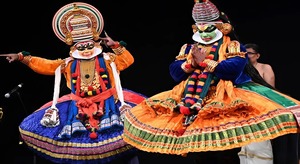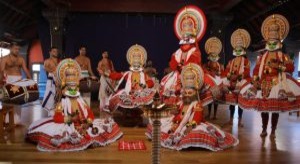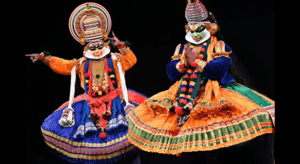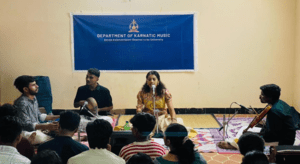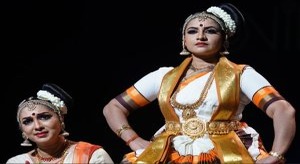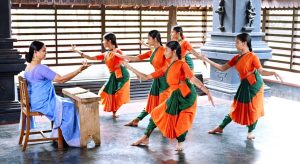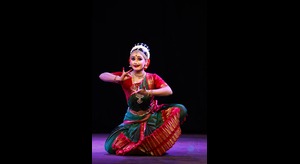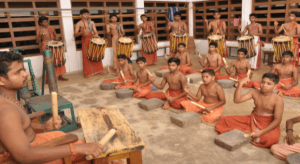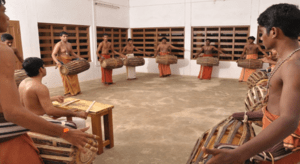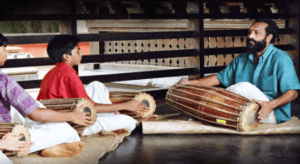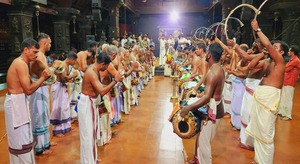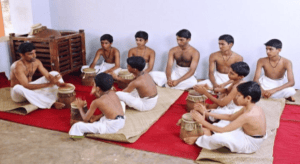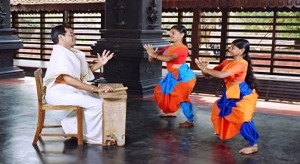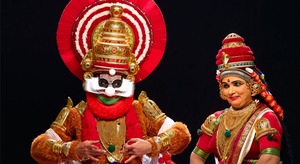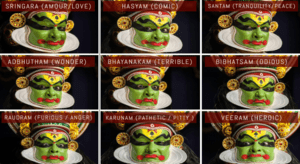Thakazhi Kunju Kurup

Guru Kunju Kurup was a highly respected Kathakali actor and teacher who had a direct and significant relationship with Kerala Kalamandalam. He was one of the early teachers at the institution, which was founded by the poet Vallathol Narayana Menon in 1930 to preserve and promote the traditional arts of Kerala, particularly Kathakali. Kunju Kurup was appointed as a tutor at Kerala Kalamandalam at the invitation of Vallathol Narayana Menon. He was a member of the Kathakali faculty in the 1930s.
He taught some of the most famous Kathakali artists who would later emerge from Kalamandalam, including the legendary Kalamandalam Krishnan Nair and Guru Gopinath.
He was considered a founding member and a crucial figure in the early years of the institution, helping to establish it as a premier center for Kathakali training. While at Kalamandalam, he contributed to the development of new aesthetics in Kathakali, known for his masterful presentation of rasa and bhava abhinaya (emotional expression). Guru Kunju Kurup was a key figure in the establishment and early years of Kerala Kalamandalam, serving as a highly influential teacher who helped shape the next generation of Kathakali masters. While Vallathol Narayana Menon was in Kunnamkulam as the editor of the magazine “Atmaposhini,” he saw Guru Kunju Kurup’s Kathakali performance. This inspired Vallathol to establish Kalamandalam, and he appointed Kunju Kurup as the main guru there. Even before this, Guru Kunju Kurup was a leading teacher and performer at the Kathakali kalari(school) run under the leadership of Kakkad Karanavarppad.
Read More
Vallathol Narayana Menon was part of a pan-Indian, nationalist movement to revive and preserve India’s cultural heritage. Tagore’s establishment of Visva-Bharati University and Santiniketan in Bengal was a pioneering effort in this direction, and it served as an inspiration for institutions like Kerala Kalamandalam. Tagore was deeply impressed by Kathakali. After seeing performances of Guru Kunju kurup. This led to a significant cultural exchange. Tagore invited Kathakali artists and teachers to Santiniketan to teach the dance form. While the specific mention of Guru Kunju Kurup teaching there is not widely documented, a student of Kunju Kurup’s, Guru Gopinath, performed for Tagore. A Kathakali artist named Kelu Nayar was also sent to Santiniketan by Vallathol at Tagore’s request. This exchange shows a direct line of influence from the Kathakali gurus of Kerala Kalamandalam to Tagore’s institution. As a founding teacher at Kerala Kalamandalam, Guru Kunju Kurup was at the heart of the institution that was supplying the Kathakali expertise that Tagore was so eager to incorporate into his own educational and artistic vision. He was a central figure in the Kathakali revival that caught Tagore’s attention.
In essence, while Tagore and Kunju Kurup may not have been close personal friends, they were two towering figures who worked in parallel, each in his own region, to ensure the survival and flourishing of India’s classical arts. Their relationship is best understood as a symbolic one, with Kunju Kurup representing the Kathakali tradition that Tagore so admired and helped popularize through his efforts at Santiniketan. Guru Kunju Kurup was a highly acclaimed Kathakali artist and teacher. Kunju Kurup was awarded the Padma Bhushan, the third-highest civilian award in India, in 1971,Padma Shri in 1965.
Guru Kunju Kurup was born in 1881 and died in 1972.
Pattikkamthodi Ravunni Menon
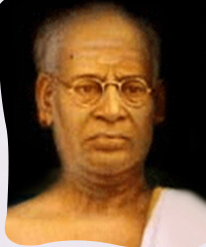
Of the several schools of learning prevalent in Kathakali at present Kalluvazhi school alone can claim universal recognition and prestige. Kalamandalam is the pioneering institution preserving and promoting the Kalluvazhi school of Kathakali. The late Pattikkaamthoti Ravunni Menon was its doyen. He chiselled the techniques of acting in Kathakali in tune with the text and context of the Kathakali plays. Credit for integrating vocal and instrumental music in Kathakali to its visual rhythm goes exclusively to Ravunni Menon. Menon joined Kalamandalam as the Head of the Faculty of Kathakali in 1933 at the invitation of Poet Vallathol. Ravunni Menon breathed Kathakali and became the mentor of all the outstanding artists in the field. Menon gave his inestimable services to Kalamandalam till 1943. His demise in 1948 was an irreparable loss to Kalamandalam and to the art of Kathakali.
Thiruvillwamala Venkichan Swamy
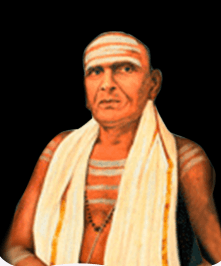
The indigenous percussion ensemble in Kerala received a scientific tone and temperament in the early decades of the 20th century under the creative guidance of a few titans. One among them was Thiruvillwamala Venkichan Swamy.Hailing from theThruvillwamala village of Thrissur District, Swamy became the greatest exponent of Maddalam both in Panchavadyam (temple orchestra) and in Kathakali. Poet Vallathol welcomed him to Kalamandalam in the 1930’s. As an exemplary teacher and peerless performer, Swamy soon became the cynosure of all eyes. He systematized the performance of Maddalam in Panchavadyam and Kathakali. But for him, Panchavadyam and Kathakali Maddalam would not have received a scientific structure and syllabi. Swamy taught both Maddalam and Chenda at Kalamandalam. His contributions to the percussion ensemble of Kerala are preserved and promoted by his distinguished disciples.
Kalamandalam Krishnan Nair
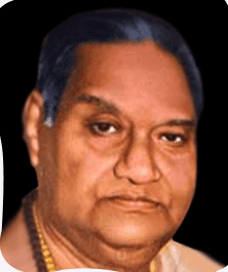
Krishnan Nair is one of the first offsprings of Kalamandalam. Hailing from North Malabar he learnt the rudimentary lessons of Kathakali under Guru Chandu Panickar at the Varanakkottu Mana near Kannur. Vallathol brought him to Kalamandalam in 1930 where he recieved rigorous training in Kathakali under the titan Pattikkaamthoti Ravunni Menon. As he grew up Krishnan Nair was carried away by the grace and emotive acting of Thakazhi Guru Kunchu Kurup. Krishnan Nair left Kalamandalam in the early forties and moved to south Kerala. He was soon to become the most popular free-lance artiste in Kathakali. He combined stylized and realistic acting in the stage presentation of the major Kathakali characters. Endowed with an expressive face, elegant appearance and a romantic-cum-humorous approach to characters Krishnan Nair easily became the mega-star in Kathakali. He was more at ease with emotionally charged characters like King Nala, Rukmaangada and the major brahmin characters than with technically disciplined characters such as Dhramaputra, Raavana and Narakaasura. Krishnan Nair, who won many titles and honours like Padmashree and Central Sangeet Natak Academy Award, passed away at the age of 78. The latter part of the history of Kathakali in the twentieth century has a lot to comment on the sterling performances of Krishnan Nair and his immense popularity.
Kalamandalam Neelakantan Nambisan
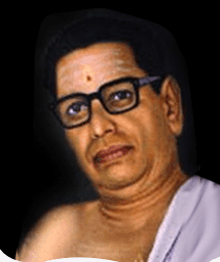
Like Krishanan Nair, Neelakantan Nambisan is one of the oldest offsprings of Kalamandalam. He was the first student to learn Kathakali Music from Kavassery swamikutty Bhagavathar and Mundaya Venkitakrishna Bhagavathar, then teacher at Kalamandalam. It was Venkitakrishna Bhagavathar who revolutionized Kathakali vocal music by restructuring its mode of rendition and introducing appropriate ragas for the evocation of the many moods of characters and for contextual emotions. Bhagavathar passed his style and knowledge on to his intimate disciple Neelakantan Nambisan. Nambisan with a missionary zeal developed the music of his Guru and popularized it far and near. Nambisan was not only a celebrated vocalist, he was also a highly disciplined teacher. The most favored voices in the field of contemporary Kathakali Music have their source in Nambisan. He retired as Principal of Kalamandalam in the early eighties and was the hero of Kathakali Music till his passing away in 1985.
Thottasserry Chinnammu Ammu
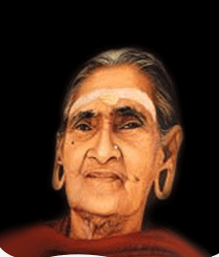
Mohiniyattam, the sole female classical dance of Kerala was nearly extinct towards the dawn of the twentieth century. For poet Vallathol it was a hard task to find Mohiniyattam teachers for imparting training at Kalamandalam. Responding to his invitation Thottassery Chinnammu Amma came to Kalamandalam in 1950. She had by then forgotten most of the items of Mohiniyattam she had learnt during her formative period. Chinnammu Amma gradually recollected several items which helped the restucturing and systematization of Mohiniyattam initiated by Vallathol with the collective support of its vocalists and instrumentalists. Chinnammu Amma was graceful in appearance and movements even in old age. She taught at Kalamandalam a group of promising dancers. Kalamandalam Satyabhama, Chandrika, and Kshemavathy the leading dancers of the successive decades, are the contributions of Chinnammu Amma to Mohiniyattam.

